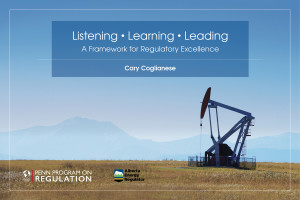
Professor Cary Coglianese identifies the key elements of regulatory excellence.
Ancient Greek philosophers called it arête: “virtue” or, in what is generally thought the better translation, “excellence.” For the Ancient Greeks, excellence was the key to human fulfillment, a vital aspiration for citizens and rulers alike. Today, excellence remains the hallmark of professional achievement in every field of endeavor – as it especially should be when the well-being of others is at stake. Atul Gawande, for example, explains in his recent book, Better, why excellence on the part of physicians is so important. He says that, for doctors, “lives are on the line…We also face daunting expectations…The steps are often uncertain. The knowledge to be mastered is both vast and incomplete. Yet we are expected to act with swiftness and consistency…We are also expected to do our work humanely, with gentleness and concern.”
Gawande could just as well have been writing about regulatory officials. Few government professionals today work so vitally at the front lines of human welfare as do regulators. Around the world, regulators play key roles in protecting their publics from harms associated with economic activity and technological change – injuries and illnesses, environmental damage, financial risks – while simultaneously promoting economic growth and development. Not only are many regulators also doing work with lives on the line, but they also all face daunting societal expectations, with vast and uncertain challenges that call for swift, consistent action as well as humane, empathic interaction with the public. Confronted with the need to integrate and achieve multiple objectives in a manner consistent with democratic principles and the best available scientific knowledge, regulators’ quest for excellence is often a monumental challenge.
But what exactly does excellence mean for regulatory organizations? For the last year, I worked with a team of researchers at the Penn Program on Regulation (PPR) team to answer this question as part of a project funded by the Alberta Energy Regulator. We held several dialogue sessions with international experts as well as interested members of the Albertan public, hearing the views of hundreds of thoughtful individuals. We also conducted extensive research, producing or commissioning more than thirty-five research reports and papers. Throughout all that we did, we encountered a plethora of attributes that others use to define regulatory excellence: transparent, smart, fair, firm, consistent, flexible, accountable, adaptive, trustworthy, effective, credible, equitable, efficient, timely, responsive . . . and the list goes on. It is probably only a small exaggeration to say that almost every positive adjective one can imagine has been used by someone to characterize an excellent regulator.
There is no denying the value of any of these attributes individually, but using all of them to build a model of an excellent regulator seems a bit like constructing a super-superhero by combining the powers of Iron Man, Hulk, Superman, Wonder Woman, Thor, Spiderman, and the Fantastic Four. (This is not to suggest that an excellent regulator must be superhuman. Nor is it to deny that combining all those superpowers would make for one formidable action figure!) It is true that an excellent regulator does need to exhibit a plethora of attributes; it is just that the longer the list of attributes grows, the more it begins to look itself like a highly detailed rule-book.
To move a large, complex organization like a regulatory body forward and improve its performance, everyone in that organization needs to know and exhibit the essential components of regulatory excellence. To be meaningful, general attributes of regulatory excellence need to focus attention.
What we need to do is break down regulatory excellence into its core attributes, just as chemists break down physical matter into its component parts. When we treat regulatory excellence as a molecule – let us call it “RegX,” for Regulatory Excellence – it became clear to me that it is made up of three essential “atoms”: Utmost Integrity; Empathic Engagement; and Stellar Competence. These three atoms encompass the myriad attributes that we documented in all our research, interviews, and dialogue sessions over the last year. The adjectives “utmost,” “empathic,” and “stellar” intentionally should remind all of us that although even merely good regulators will need integrity, engagement, and competence, excellent regulators must possess these attributes in abundance and demonstrate them consistently.
The Utmost Integrity atom is about much more than just a lack of corruption – although it is certainly about that too. Foundationally, it is about deeper character: a commitment to serving the public interest, to respecting the law and duly elected representatives, to taking evidence and analysis seriously, to admitting and learning from mistakes, and so forth. Attributes such as “honesty,” “humility,” and “public-spirited” all fit within this category. But so too will “courage,” as seeking to act in a way that advances overall public value will, by necessity for a regulator, require making decisions that will displease some segments of society, including sometimes some of the most powerful segments.
The Empathic Engagement atom is about transparency and public engagement; it is about how a regulatory organization interacts with the public. Does it, for example, provide adequate public notice of its activities? Does it affirmatively solicit public input and seek to educate the public? Just as importantly, empathic engagement refers to the attitudes a regulatory organization’s employees exhibit when they interact with others. This encompasses how inspectors treat the managers of the facilities they are inspecting – as well as how the person picking up the phone in headquarters treats the non-native language speaker who has a question. Do they treat others respectfully – even those being inspected? Do they assume at the outset that noncompliance might not always stem from ill will? Finally, when they make decisions, do they provide clear, sincere, and coherent reasons for them?
The Stellar Competence atom is about delivering substantive outcomes and achieving high performance – and everything else a regulator must do to advance those substantive outcomes that yield maximal public value. The criterion of efficiency – which we found referenced in 90% of the regulatory strategic plans we looked at from across nine different countries – fits into this category, and so too does effectiveness and the distributional equity of outcomes. Competence, though, is also about various qualities related to best practices, such as proportionality, flexible instruments, and risk-informed priority-setting. Included too are numerous qualities that describe regulatory personnel, their technical knowledge and skill, as well as other organizational resources needed to deliver stellar outcomes, such as adequate fiscal resources, state-of-the-art information technology systems, and so forth.
As I make clear in a final report to the Alberta Energy Regulator released publicly yesterday, the three atoms of the RegX molecule can be used to organize and make sense of all of the many other attributes we discovered in our research and heard offered in our interviews and dialogue. Of course, although excellence requires consistently living out the attributes of utmost integrity, empathic engagement, and stellar competence, excellence is not the same as perfection. Mistakes will happen and nefarious illegal behavior may sometimes go undetected, even under the best regulatory systems. The truly excellent regulator will and must, though, always strive for perfection and never be truly satisfied with anything short of it.
This essay is part two of a three-part series highlighting the release of the Best-in-Class Regulator Initiative’s final report.
This essay was prepared as part of the Alberta Energy Regulator-sponsored Best-in-Class Regulator Initiative, for which Coglianese serves as the principal investigator and project director.




